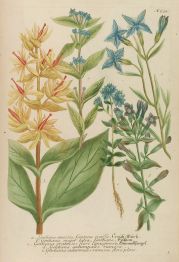Gentian Blues
By Audrey Stallsmith

Thou waitest late, and com'st alone,
When woods are bare and birds are flown,
And frosts and shortening days portend
The aged year is near an end.
William Cullen Bryant, "To the Fringed Gentian"
Depending on whom you believe, the gentian is either a cursedly difficult flower to grow--or it has been unfairly saddled with that reputation! It does seem to thrive better in the wild than at the hands of man, perhaps because many species originated in mountainous regions and prefer an uncommon combination of both sun and cool temperatures.
In one of Amy Lovell's poems, a little girl comments on her mother's rule that "never/ Must we pick any gentians--ever!/ For if we carried them away/ They'd die of homesickness that day."
The often "startling" blue of the plant's blooms, however, make it much coveted in the gardening world, where too many "blue" flowers are actually shades of purple. Most gentians also bloom late in the year, in striking contrast to the typical golds and rusts of autumn. So stubborn gardeners will keep trying to make the plant which stands for "loveliness" happy!
Poets also cannot resist this flower. D.H. Lawrence wrote moodily, "Not every man has gentians in his house/ In Soft September, at slow, sad Michaelmas./ Bavarian gentians, big and dark, only dark/ darkening the day-time torch-like with smoking blueness of Pluto's gloom." (Pluto was the mythological god of the dead.)
Although gentian has become another word for blue, not all members of the family boast that color. The most common medicinal type, Gentiana lutea, has yellow flowers, and a few South American and New Zealand varieties are red.
The gentian is named for an Illyrian king named Gentius, who reigned from 180 to 167 B.C. and discovered the plants medicinal uses. (Illyria was near present-day Bosnia.) Years later, a much-beloved monarch of Hungary named Ladislas, who was later made a saint, is supposed to have asked God to lead him to a cure for the plague. He then fired an arrow into the air and, falling, it pierced the root of a gentian plant. Culpeper agreed that "a more sure remedy cannot be found to prevent the pestilence."
As one of the bitter herbal tonics, gentian root does, in fact, improve overall health by strengthening the digestive system, plus stimulating circulation and appetite. It also purifies the blood and assists liver function, besides having an ancient reputation as an antidote for poison.
The fall-blooming varieties are said to be the easiest to grow, with two of the best for beginners being Gentiana septemfida (Everyman's Gentian) and Gentiana cruciata (Cross-leaf Gentian).
Emily Dickinson wrote of a little gentian who tried to be a rose, but could not bloom in the warmth of summer. "The frosts were her condition," the poet concluded. "The Tyrian would not come/ Until the North evoked it. . ." In the same way, perhaps some of us require difficult conditions to bring out our full potential!
Autumn gentians image is from Phytanthoza Iconographia, courtesy of the Missouri Botanical Garden.








